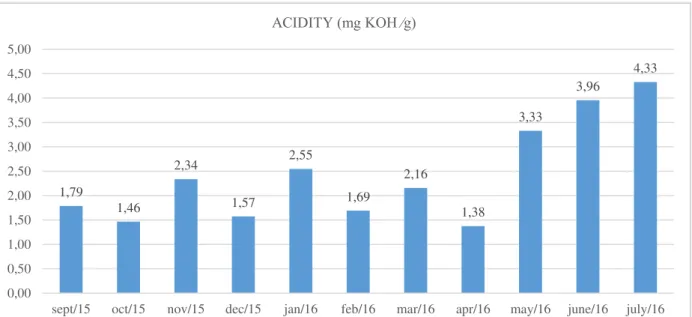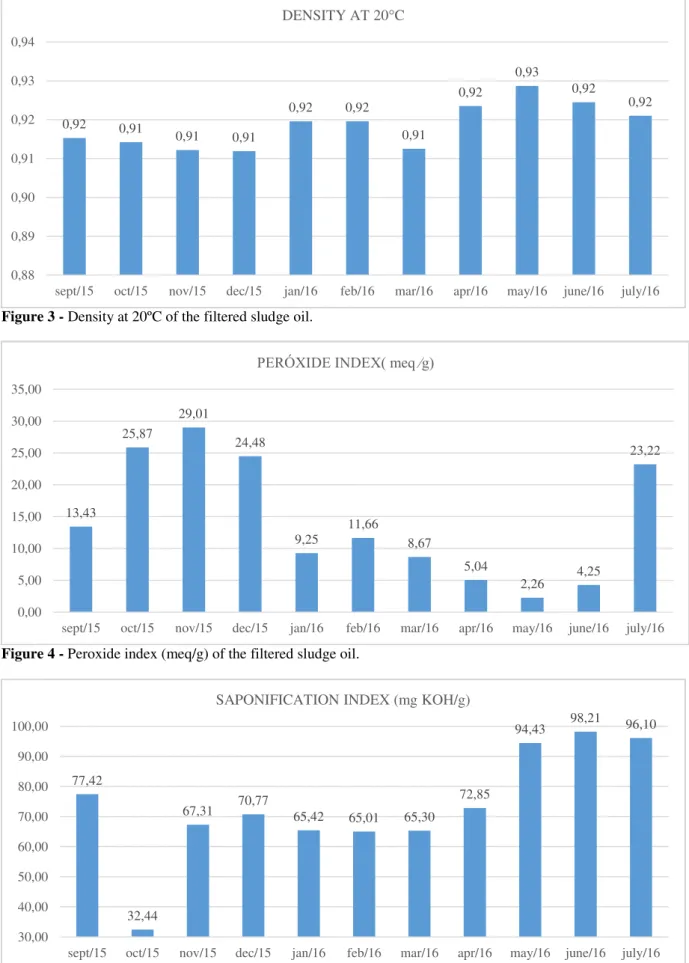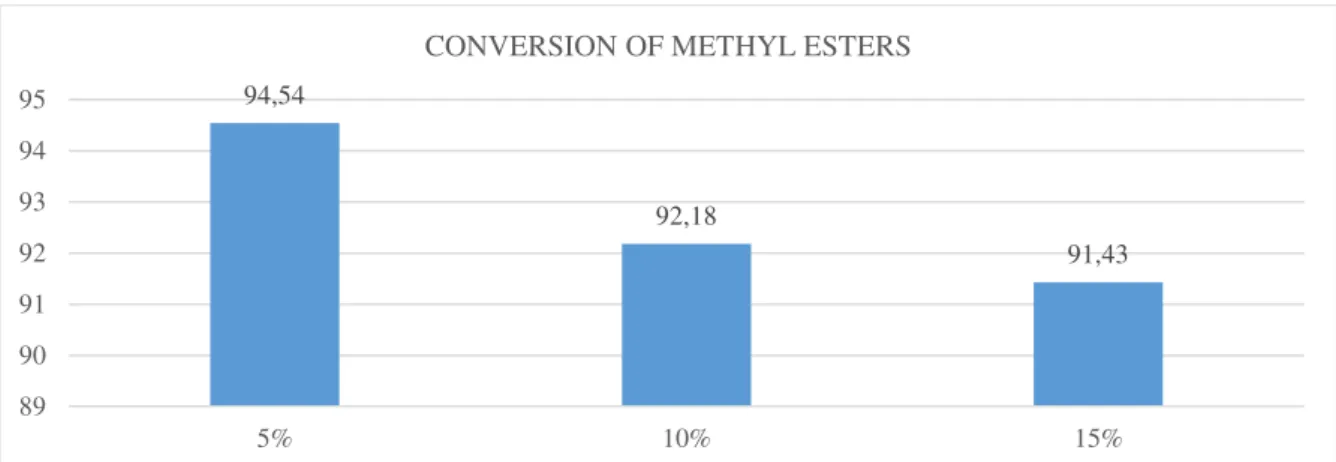Braz. Arch. Biol. Technol. vol.61, no.spe:e18000015 2018 Vol.61, no.spe: e18000015, 2018
http://dx.doi.org/10.1590/1678-4324-smart-2018000015 ISSN 1678-4324 Online Edition
BRAZILIAN ARCHIVES OF BIOLOGY AND TECHNOLOGY
A N I N T E R N A T I O N A L J O U R N A L
Physicochemical Characteristics of Oil Obtained from the
Treatment of Poultry Abattoir Effluents and its Potential for
Biodiesel Production
Sheila Simone Kunh
1, Fabiana de Marqui Mantovan
2, Maria Cristina Milinsk
2, Helton
José Alves
11Universidade Federal do Paraná – Laboratório de Catálise e Produção de Biocombustíveis (LabCatProBio),
Palotina, Paraná, Brasil. 2Universidade Federal do Paraná – Laboratório de Controle de Qualidade em Biocombustíveis, Palotina, Paraná, Brasil
ABSTRACT
Sludge oil derived from the effluent generated in poultry abattoirs offers a promising biomass for the production of biodiesel. In this work, determination was made of its physicochemical characteristics, including acidity, density at 20ºC, peroxide index, moisture content, and saponification index, together with evaluation of a route for its conversion to biodiesel.
Keywords: Oil sludge, biomass, biodiesel, renewable energy sources, abattoir effluents.
Author of correspondence: sheilasimone@hotmail.com
Braz. Arch. Biol. Technol. vol.61, no.spe:e18000015 2018
INTRODUCTION
The process of treatment of abattoir effluents begins with removal of the solids by flotation of the raw effluent, generating material known as sludge. In some abattoirs, this undergoes heat treatment for separation into three streams: low humidity sludge, sludge oil (acidic in nature), and clarified oil. Around 0.35-0.50% of the weight of the poultry slaughtered is transformed into sludge oil. As a result, in the Brazilian poultry sector, there is an estimated potential production of over 80,000 tons of this oil annually. The sludge oil is currently used as fuel in boilers, as a substitute for traditional biomass. A sustainable alternative destination for these byproducts involves their recycling, which can reduce environmental impacts and provide a source of revenue and/or reduce operational costs. The aim of the present study is to characterize the potential of oil obtained from the treatment of poultry abattoir effluents as a raw material for biodiesel production.
METHODS AND MATERIALS
Sludge oil samples were supplied by a poultry abattoir in the western region of the State of Paraná. Samples were collected for 11 consecutive months from September 2015 to July 2016. The sludge oil samples were heated to 70ºC, until a clear and emulsion-free appearance was obtained, then filtered through filter paper, hence removing larger particles and microparticles. The filtered oils were analyzed to determine acidity, density at 20ºC, peroxide index, moisture content, and saponification index, according to the methods described by IAL1. Three blends were produced, with 5, 10, and 15%
sludge oil added to soybean oil, and basic transesterification was performed with 0.5% NaOH, using a molar ratio of 1:6 with methanol. The conversion to esters was determined using gas chromatography, employing a Trace 1310 instrument (Thermo Scientific) equipped with a flame ionization detector (FID), PTV injector (split mode) and a Wax capillary column (30 m x 0.25 mm i.d. x 0.25 μm stationary phase). The kinematic viscosity of the methyl esters obtained was determined according to ABNT Standard NBR 10441.
RESULTS AND DISCUSSION
The data obtained showed that evaluation of the parameters measured was necessary in order to define the best reaction mechanism for the use of this sludge oil in biodiesel production. The degree of acidity is shown in Figure 1. For the production of biodiesel, an acid catalysis reaction can be used to decrease the neutralization step in the process, or blends can be produced together with a raw material of low acidity index, in order to maintain the basic transesterification reaction. Figure 2 shows the moisture content, which varied from 0.05 to 0.89% (m/m) for the months analyzed. This could have been related to seasonal precipitation, since the storage tanks were open to the atmosphere. This information is important in the production of biodiesel, since the presence of water can lead to hydrolysis reactions, inflicting on the yield and causing final storage difficulties. Figure 3 shows the density of the sludge oil during the period, with no significant variations. The peroxide index (Fig. 4) is an important parameter, since it is directly related to degradation. The decrease in the index over the months could have been due to the consumption of peroxide in subsequent oxidation reactions. According to NAWAR2, this process can be accelerated if the oil is contaminated with a metal that
Braz. Arch. Biol. Technol. vol.61, no.spe:e18000015 2018
chloride used as a coagulant. The saponification index (Fig. 5) was related to the chemical composition of the oil. Figure 6 shows the results of the transesterification of the three blends, with additions of 5, 10, and 15% of the sludge oil to soybean oil. Conversion exceeding 90% was achieved in all three cases, demonstrating the feasibility of using the sludge oil for the production of biodiesel employing the basic transesterification reaction. Figure 7 shows the kinematic viscosities at 40ºC of the esters obtained from each blend. All the values were between 3.0 and 6.0 mm2/s, as
required by legislation.
Figure 1 - Acidity (mg KOH/g) of the filtered sludge oil.
Figure 2 - Moisture content (% m/m) of the filtered sludge oil. 1,79
1,46
2,34
1,57
2,55
1,69
2,16
1,38
3,33
3,96
4,33
0,00 0,50 1,00 1,50 2,00 2,50 3,00 3,50 4,00 4,50 5,00
sept/15 oct/15 nov/15 dec/15 jan/16 feb/16 mar/16 apr/16 may/16 june/16 july/16
ACIDITY (mg KOH ∕g)
0,05
0,39
0,49
0,16
0,60
0,89
0,29
0,43
0,13
0,33
0,46
0,00 0,10 0,20 0,30 0,40 0,50 0,60 0,70 0,80 0,90 1,00
sept/15 oct/15 nov/15 dec/15 jan/16 feb/16 mar/16 apr/16 may/16 june/16 july/16
Braz. Arch. Biol. Technol. vol.61, no.spe:e18000015 2018
Figure 3 - Density at 20ºC of the filtered sludge oil.
Figure 4 - Peroxide index (meq/g) of the filtered sludge oil.
Figure 5 - Saponification index (mg KOH/g) of the filtered sludge oil.
0,92 0,91
0,91 0,91
0,92 0,92
0,91
0,92
0,93
0,92
0,92
0,88 0,89 0,90 0,91 0,92 0,93 0,94
sept/15 oct/15 nov/15 dec/15 jan/16 feb/16 mar/16 apr/16 may/16 june/16 july/16 DENSITY AT 20°C
13,43
25,87
29,01
24,48
9,25
11,66
8,67
5,04
2,26 4,25
23,22
0,00 5,00 10,00 15,00 20,00 25,00 30,00 35,00
sept/15 oct/15 nov/15 dec/15 jan/16 feb/16 mar/16 apr/16 may/16 june/16 july/16 PERÓXIDE INDEX( meq ∕g)
77,42
32,44
67,31 70,77 65,42 65,01 65,30
72,85
94,43 98,21 96,10
30,00 40,00 50,00 60,00 70,00 80,00 90,00 100,00
Braz. Arch. Biol. Technol. vol.61, no.spe:e18000015 2018
Figure 6 - Conversion of methyl esters with addition of 5, 10, and 15% of sludge oil to soybean oil.
Figure 7 - Kinematic viscosities of the methyl esters obtained from the blends of 5, 10, and 15% of sludge oil with soybean oil.
CONCLUSIONS
Physicochemical characterization of sludge oil is an essential tool for evaluation of its potential as raw material for biodiesel production3. Knowledge of the moisture and
acidity contents is fundamental for determining the route to be used for biodiesel production4 and to ensure a conversion rate that provides the best cost-benefit ratio in
using raw material from an agro-industrial process. The results of the analyses for the proposed blends were satisfactory, with maintenance of the basic transesterification reaction and conversion exceeding 90% with the possibility of adding up to 15% of the sludge oil to soybean oil. These findings show that the sludge oil obtained from the treatment of poultry effluents presents suitable physicochemical characteristics for use as raw material in the production of biodiesel, capable of generating environmental benefits.
ACKNOWLEDGEMENTS
The authors are grateful for the technical support provided by UFPR (Palotina Sector) and CCDM-DEMa (UFSCar).
94,54
92,18
91,43
89 90 91 92 93 94 95
5% 10% 15%
CONVERSION OF METHYL ESTERS
4,194
4,457
4,584
3,9 4 4,1 4,2 4,3 4,4 4,5 4,6 4,7
5% 10% 15%
Braz. Arch. Biol. Technol. vol.61, no.spe:e18000015 2018
REFERENCES
1. Instituto Adolfo Lutz. Métodos Físico-Químicos para Análise de Alimentos. 1. ed digital. São Paulo: Instituto Adolfo Lutz, 2008. cap. XVI, p. 593-629.
2. Nawar WW. Lipids. In: FENNEMA, O. R. (Ed.). Foods Chemistry. 3. Ed. New York: M. Dekker, 1996. p. 225-319.
3. Oliveira SM. Blenda de Sebo Bovino/Óleo de Fritura: proposta de produção de éster etílico a partir da reciclagem de resíduos. 2014 . 67f. Dissertação (Mestrado em Bioenergia) - UEM
– Universidade Estadual de Maringá. Maringá, 2014.
4. Parente EJS. Biodiesel: Uma aventura tecnológica num país engraçado. Fortaleza: Tecbio,
2003. 68 p.


